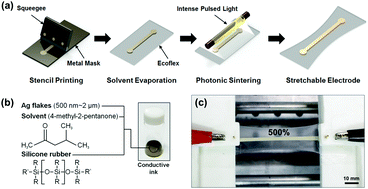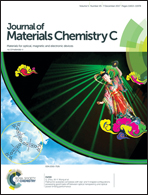Selective photonic sintering of Ag flakes embedded in silicone elastomers to fabricate stretchable conductors†
Abstract
Stretchable conductors have recently attracted much attention because of rapid developments in wearable and deformable electronics. Conductors are one of the essential components of electronic devices. A photonic sintering process with intense pulsed light from a xenon lamp is used for sintering printed ink to fabricate conductors, without damaging the substrate. However, it is difficult to achieve the most desired properties such as high conductivity and mechanical stretchability in stretchable conductors fabricated by photonic sintering. Here, highly stretchable conductors are developed by the selective sintering of conductive materials embedded in silicone elastomers, overcoming this drawback. The conductors are composed of conductive Ag flakes and elastomeric Ecoflex. Photonic sintering generates conductive paths without damaging the transparent elastomer. As a result, a stretchability of 500% is achieved without the need for any structural designs. Furthermore, a wireless power transfer circuit incorporating the conductors was successfully applied to operate a light emitting diode wirelessly. This approach opens up the possibility of developing new types of stretchable and deformable electronics for future applications.



 Please wait while we load your content...
Please wait while we load your content...